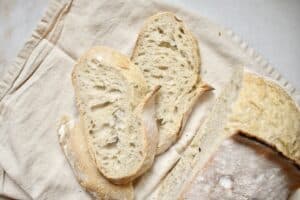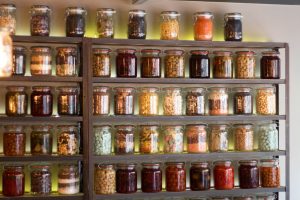As we near the holiday season, time often seems to slip away quickly between bustling preparations, festive parties, and travel plans. In the midst of all this activity, we sometimes just need a quick, wholesome meal to refuel. Or, perhaps we have a smattering of odds and ends leftover from family dinners that deserve some creative repurposing. In these situations, meals like stir-fries, salads, and pasta are natural “kitchen sink” options, allowing us to pull together lots of disparate ingredients into something cohesive.
But, I would argue that frittatas are an even more versatile “kitchen sink” solution. Not only can they be enjoyed for breakfast, lunch, or dinner, but their simple formula of eggs, vegetables, meat, and cheese makes them the perfect canvas for using up all sorts of surplus ingredients. Pair a frittata with fresh fruit and toast, or serve it alongside a green salad, and you’ve got a nourishing meal ready in a flash, no matter the time of day.
By mastering the core building blocks of frittata preparation, you can endlessly riff on flavor combinations to suit any occasion – whether that’s clearing out the crisper with end-of-season veggies or putting a creative spin on your Thanksgiving leftovers. In this guide, we’ll cover the essential elements for crafting the perfect frittata, so you can turn your kitchen scraps into a delicious and satisfying meal anytime.

What is a Frittata?
A frittata is an Italian egg-based dish that usually incorporates vegetables, meat, and cheese. It’s assembled in a skillet and either cooked completely on the stovetop (you have to flip this version), or started on the stove and finished in the oven (way easier).
You might see them referred to as crustless quiches. However, quiches differ in three main ways: quiches are baked in a crust, have a larger ratio of cream to eggs, and bake longer. They’re both delicious!
Frittata Building Blocks
There is no one right way to build a frittata, but following a few guidelines can help you whip up a delicious meal all while reducing food waste, and saving money and effort. Here’s what you need to consider:
- Skillet – It’s best to use an oven-safe skillet with a non-stick surface. Cast iron is a great candidate. The diameter of your pan will dictate the number of eggs and the amount of filling to use so you don’t under or overfill the pan. The size and type of pan will also impact the overall cook time.
- Egg and dairy – Eggs are whisked with some form of dairy. The dairy adds richness and a more tender texture. I recommend heavy cream, half-and-half, or whole milk.
- Cheese – The amount you use will depend on the texture and type. For example, you might use less Parmigiano Reggiano which has a fine texture when grated and a salty, punchy flavor. You can use more of a cheddar that increases in volume when shredded and has a milder flavor. (Have fun dropping dollops of goat cheese, brie, or other cheeses!)
- Meat and vegetables – These fillings should be precooked before adding them to your frittata. The overall cook time of a frittata may not be enough to safely cook raw meat, and raw vegetables contain a lot of moisture that can make your frittata soggy and unappealing. That’s why leftovers are perfect! If you’re starting with raw ingredients, roast or sauté them first.
- Oven temperature – Frittata recipes have a wide range of oven temperatures. I’ve seen everything from 325°F to 425°F. Cooking at a lower temperature will take longer and may not get a nice rise. Cooking at a higher temperature may result in uneven cooking and overdone edges. I like to be somewhere in the middle and recommend 350°F or 375°F…and always preheat!
- Bake time – Like temperature, bake times vary from recipe to recipe. The size and material of your pan, how much it is filled, and whether you par-cook on the stovetop will determine how long a frittata needs to bake. As a rule of thumb, I cook assembled frittatas on the stovetop over medium or medium-low heat for 5 minutes to set the bottom and edges, then finish it in the oven until the center is just set.

An Autumn Harvest Frittata
There are some ingredients I know will be in my fridge all autumn and winter, so I created a frittata just for this season, whether starting from scratch or using up leftovers!
This recipe features butternut squash and brussels sprouts, but swap either of those for any of these: other winter squashes (like acorn, delicata or kabocha), sweet potato, kale, chard, and broccoli…just to name a few. You can omit the bacon or use other meats like sausage, leftover roasted turkey or chicken. Your cheese possibilities are endless, too!

Recipe Steps
If you’re starting with leftover veggies or meat, you can skip ahead to sauteeing the aromatics. If not, roast the veggies while you begin the next steps.
- Roast the vegetables – Toss the butternut squash and Brussels sprouts with olive oil, salt and pepper. Arrange in a single layer on a baking sheet and roast for 20 to 25 minutes in a preheated 375°F oven.
- Crisp the bacon – Start the bacon in a cold skillet, then cook over medium heat until crisp. Transfer to a paper towel to drain, but reserve some of the fat in the pan.
- Sauté the aromatics – Cook the shallot until tender, then add the garlic and sage and cook for another minute.
- Whisk the eggs – Combine the eggs, half-and-half, salt and pepper in a large bowl. Whisk vigorously to combine.
- Assemble the frittata – Return the bacon to the skillet; add the squash and sprouts. Spread everything in an even layer. Pour in the eggs, then top with cheese. Cook the frittata over medium-low until the edges are set.
- Bake – Transfer the skillet to the oven and bake for 15 to 20 minutes until the center is just set. Remove it to a trivet to rest for 5 minutes.

And just like that, breakfast / lunch / dinner is done! Have fun customizing quick and easy frittatas using the building blocks!

Linda Feller has been a Plan to Eat superfan since 2013 and will gush about the app with anyone who expresses the least bit of interest. She is a recipe developer, food photographer and the gal behind Sip + Sanity, recipes for entertaining and celebrating.
FB | Instagram | Pinterest: @sipandsanity
Autumn Harvest Frittata
Source: Sip + Sanity | Linda Feller for Plan to Eat
Course: Breakfast
Prep Time: 5 min
Cook Time: 1 hr
Total Time: 1 hr 5 min
Yield: 6 to 8 servings
Serves:
Ingredients
- 2 cups butternut squash cut into 1/2-inch cubes
- 2 cups brussels sprouts trimmed and quartered
- 2 tablespoons olive oil
- kosher salt and pepper to taste
- 4 slices bacon diced (optional)
- 1 shallot diced
- 2 cloves garlic minced
- 2 tablespoon fresh sage chopped
- 10 large eggs
- 1⁄2 cup half and half
- 4 ounces Gruyere cheese shredded (or aged cheddar)
Directions
- Preheat oven to 375°F. Toss butternut squash and brussels sprouts with 2 tablespoons of olive oil, kosher salt, and pepper. Roast for 20-25 minutes until tender. (Skip this step if using leftover veggies.)
- While veggies roast, add the bacon to a cold 10-inch oven-safe skillet; cook over medium heat until crispy. Remove the bacon to paper towels using a slotted spoon, leaving about 1 tablespoon of fat in the pan.
- In the same skillet over medium heat, sauté the shallot until softened, about 2 to 3 minutes. Add the garlic and sage; cook 1 minute more. (Take the skillet off the burner while you do the next step.)
- Whisk the eggs, half and half, 1/2 teaspoon kosher salt, and 1/4 teaspoon fresh cracked pepper in a large bowl until well combined.
- Add the roasted veggies and bacon back to the skillet. Pour the egg mixture over vegetables. Sprinkle the cheese on top. Reduce the heat to medium-low, and cook undisturbed for about 5 minutes, until the edges begin to set.
- Transfer the skillet to the oven and bake 15-20 minutes until center is set and the edges are lightly golden.
- Let rest 5 minutes before slicing and serving.
Amount Per Serving (6)
- Calories: 310
- Protein: 21 g
- Sugar: 3 g
- Carbohydrate: 9 g
- Fat: 22 g
- Saturated Fat: 9 g
- Cholesterol: 341 mg
- Sodium: 331 mg
- Fiber: 2 g







